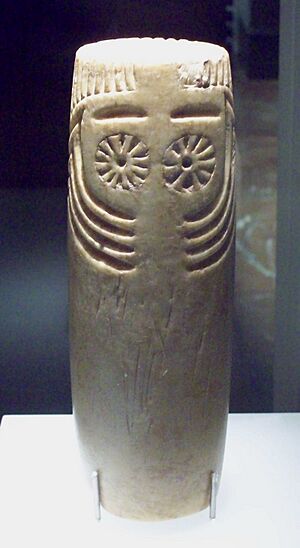Iberian schematic art facts for kids
Iberian schematic art refers to ancient drawings, mostly found in caves, across the Iberian Peninsula (modern-day Spain and Portugal). These artworks are linked to the first groups of people who started working with metals. This includes the Copper Age, the Bronze Age, and even the beginning of the Iron Age.
Scientists are still discussing exactly when this art began and ended. It likely started around 4,000 BC and continued until about 1,000 BC. This means it was happening at the same time as Levantine Art in its early stages. It even lasted longer in some remote areas.
The most important feature of this art is its "schematic" style. This means artists drew figures in a very simple way. They only showed the most basic parts of something, like an animal or a person. They removed all extra details. The drawings became simple outlines, but you could still tell what they were supposed to be.
This simple style of art wasn't just in the Iberian Peninsula. It was part of a bigger art movement seen across much of Europe and the Mediterranean region. However, each area, including the Iberian Peninsula, had its own unique touches.
What is Schematic Art?
Schematic art is a way of drawing that simplifies things. To understand it better, let's look at other art styles:
- Realism means drawing things exactly as they look in real life. You can easily identify what is being shown because of all the details.
- Stylization is when artists make certain details stand out. They might repeat or change these details until the original shape looks different.
- Abstraction is art that doesn't look like anything real. It uses shapes, colors, and lines to show ideas or feelings.
Schematic art is somewhere between realism and abstraction. It's still about real things, but it's super simplified.
Where and When Was it Found?
Even within the Iberian Peninsula, schematic art isn't all the same. It was created over a very long time and in many different places. This makes it tricky for experts to study. It's hard to divide it into clear periods or regions because it was so widespread and varied.
See also
 In Spanish: Arte esquemático ibérico para niños
In Spanish: Arte esquemático ibérico para niños



